In recent years, while the pop poems of poetry slams have been
making the Sunday newspapers' magazine inserts, and the work
of the L=A=N=G=U=A=G=E poets has become competitive with
traditional poetry in most university literature departments,
several other new kinds of poetries of equal merit have been
evolving far from the notice of just about anybody but their
makers. The Experioddicist, Alabama Dogshoe Moustache,
Noosepapers, NRG, Kaldron, Score, and Missionary Stew
are the names of just a few of the generally ephemeral, never
widely-circulated periodicals examples of them can be found in.
Perhaps the most appealing of the new poetries is a variety I call
the minimalist strain because its aim is to get its job done in as
few words as possible--generally but not always through the use
of visual techniques. The term "minimalist" may cause some
confusion because of its now common use throughout the arts,
particularly in music, painting, and sculpture. In most such
instances, the term has been employed so sloppily that it seems
justifiable to give it a clearer, entirely literary focus here. Whatever
name it goes by, though, the poetry I'm speaking of bristles with
innovativeness. It is thus worth discussion both for its own sake
and as a sample of current craft-extending poetry as a whole.
It is not clear when contemporary minimalist poetry began, or
who "invented" it, but it's probable that one-word, one-phrase,
and other very compressed poems were among the oddities
thrown together by the dadaists in the twenties. At around the
same time, imagism importantly emphasized the value of
concision. A third important contribution to minimalist poetry
was made by the concrete poetry movement of the 50's and 60's
before it succumbed to narrowness of scope and various forms of
parochialism. The flowering of the haiku in the West was a large
influence, as well. To my mind, though, full-scale minimalist
poetry didn't begin in this country and Canada until the one-word
poems of Aram Saroyan and Richard Kostelanetz in the late sixties
and early seventies. The movement, if it can be called that, was
almost invisible until the mid-eighties when poets like Geof Huth,
Jonathan Brannen, Karl Kempton and others joined it. It is still
small, but large enough to make the following survey
possible.
An especially accessible example of minimalist poetry by George
Swede seems as good a place as any to start that survey:
M SS NG
Thiiief!
Here in just two words a thief's contraband is clearly and
amusingly shown rather than verbally described. Similarly likable
is Adam Gamble's
balloon!
Hold on tight to your
More ambitious are the mostly one-word visual poems of Richard
Kostelanetz's sequence, "Genesis." Each of them represents one of
the seven days of Creation in a different, page-filling typography.
"LIGHT," the first, is printed in pedestrian stenciled lettering--but
dazzles because (1) it arrives on a black page immediately after a
white page; (2) its letters are boldly solid rather than diffidently
outlined like the smaller letters of the sequence's title on the
previous page; and (3) its letters are fused, which makes them
seem not a recognizable word, but light itself--until they clarify as
an appropriately fully-unified, over-flowing proto-word for . . .
Everything.
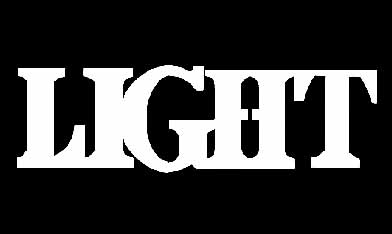
The "heaven" that follows is also spelled out on a black
background, but in stenciled fragments of lower-case letters that
seem in context appropriately star-sized. That the fragments, like
the sequence's title, are outlined adds to the effect by suggesting
starlight's leaking into the dark of night rather than blazingly
obliterating it. The remainder of Kostelanetz's sequence finishes
his story in five comparably effective steps.
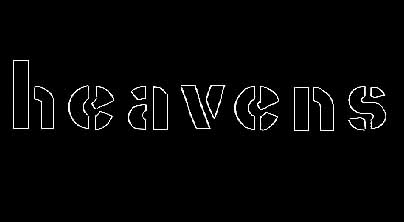
However spare the previous poems might seem, there have been
sparer ones, John Byrum's "Utter," for one. To state its title is to
describe it completely, for it comprises just the single, normal
word, "utter," in capital letters on an otherwise blank page. I have
much sympathy for anyone whose response to this is
consternation. What in the world is the point of it?
Well, when I first saw it, I was much helped by my previous
experience with works like Kostelanetz's "Genesis." I
automatically thought of the opening of the Gospel of John, "In
the beginning was the Word." "UTTER" thus seemed to me a
command to express oneself, be an artist, climb into the grand
creative power of utterance: UTTER! Such a command was
particularly appropriate in the magazine where I first encountered
it, a newsletter for a poets' association.
Then the idea of what "utter" means as an adjective occurred to
me--and expanded into thoughts of how utterance relates to
absoluteness, and how it is exclusively the act of uttering that can
truly complete any part of reality, by naming it into full
comprehensibility. The power of utter, the utter power of it!
Also in the poem for those who listen to it long enough are the
pun, "udder," and auditory hints of "upper" and "under." For so
short a work, the poem is thus extremely sensually and
connotatively rich.

However brief "Utter" is, its brevity has nothing on the "m" with
the extra leg shown above. Composed by Aram Saroyan in the
seventies, it has actually garnered a bit of fame: it was cited in
The Guinness Book of Records as the world's shortest poem!
It might have competition, though: ten or fifteen years later
jwcurry composed the one-letter poem shown next:

Neither poem, I contend, is merely a novelty. The curry piece
charmingly turns a standard, thoroughly un-unique letter i into
the very essence of individuality by giving it a thumbprint.
Along the way, it also suggests much about the mix of the human
and the abstract (flesh and geometry) that comprises the artistic
process, and about how fleetingly our writings smudge our
flamelike identities onto paper. As for Saroyan's four-legged m, it
snaps us visually into the center of an alphabet just starting to
form, between its m and n. And it brings to mind the way a
doubled u becomes a w. The poem also comes across as a pun
for the word, "am," to suggest some kind of superior, or perhaps
gross, state of being--an "am" times one-and-a-half.
The Saroyan poem reminds me of the more directly alphabet-
related poem, by Karl Kempton, that follows:

Here, instead of two letters' being jammed together, two letters are
turned into op art--to jerk a one-dimensional series of
commonplace symbols into something 3-D, and blinkingly in
motion! And we suddenly recall the large-scale real world that
the abstract alphabet, and technical devices like it, too often march
us in a tastefully, orderly fashion "beyond."
More difficult than any of the preceding is the following
minimalist poem by Geof Huth:

When I first encountered this, I tried my best to like it, Huth
being a close friend of mine. But . . . why "choice?" Why not . . .
well, "people?" E PEOPL E? That sorta suggested "E Plurabus
Unum." Indeed, any word treated the way Huth treated "choice"
would do something slightly interesting. T RIGH T? I go into
detail about this adversarial attitude of mine because it is so
typical of me--and, I think, of almost everyone who comes across
a poem like Huth's and doesn't at once connect to it. No doubt
such an attitude is at times justified, but not this time.
Or so I decided when I finally noticed the "ECHO" that was in the
poem. Why it took me so long to notice I'll never know, but it
made all the difference. I immediately saw and felt the echoing of
the E's, and the C's, and of the two instances of "E CHOIC E." I
also started hearing and being intrigued by the sound of CH in
"ECHO" versus its sound in "CHOICE," and by the similar jitter of
"E" between the sound of "eh" and silence. The hint of music --
and the dance -- in "CHOIC" ("choir," "choreography," etc.)
appealed to me as well. And the sardonic notion of
choice-as-echo, as in too many American Republicratic elections,
flickered into my reflections.
Then, as it occurred to me how opposed to each other "ECHO"
and "CHOICE" are, I realized how powerfully the poem summed
up not only all that exists in the tension between choosing and
copying, but between black and white, up and down, left and
right: its subject was Dichotomy, it was a celebration of the
perpetually closingopening cycle of blackwhite samedifferent
updown yesno that the universe is!
Infra-Verbal Minimalist Poetry
By now it should be clear that there is more than one kind of
minimalist poem. Just about all the ones I'm familiar with are
members of one or the other of two major classes of contemporary
poetry that I've dubbed infra-verbal and pluraesthetic
poetry. By "infra-verbal" I mean poems like the one preceding by
Huth, whose main focus is textual elements smaller than words,
such as letters, numerals, and even spaces. So far I've
distinguished five kinds of such poems: fissional, fusional,
mutational, microherent and alphaconceptual. There no doubt are
others.
In fissional poetry spaces are used to "disconceal" words within
words as in LeRoy Gorman's, "t rain s top spar row," and
Kostelanetz's "the rapist." Thus, in the first of these, two words
are multiplied into a whole country scene, with hints of ships, and
in the second a broken word makes a satirical comment on what a
psychotherapist can sometimes seem to be. Another specimen of
fissional poetry is Huth's "E CHOIC E."
In fusional poems words are combined as in Jonathan Brannen's,
"splace," to create implicit metaphors, in this case the splash/
splice of a space's becoming a place (like a house becoming a
home). Then there's the following poem by George Swede:
graveyarduskilldeer
Here three words are spelled together not only to produce the
richly resonant "double-haiku," graveyard/ dusk/ killdeer//
graveyard/ us/ killdeer, but strikingly to suggest the enclosure
(like letters by a word) of two or more people (a couple--or,
perhaps, all of us) by an evening -- or some greater darkening.
Sometimes categories are combined, as in the following fissional/
fusional (or compound infra-verbal) poem by Karl Kempton:
ANTIQUE QUESTION
anti quest ion
a we
awe
It is vital to read this poem both as words and letters, and to
watch as well as read it. In such a reading, and watching,
the poem should make almost tangible the idea of a question's
congealing into a serenity beyond irritable answer-seeking. And
the subsequent parallel drawing together of "a we" (or group of
individuals associating to the degree of we-ness but not any
transcendentally further) into "awe," or some higher Oneness,
should have an even more electrically almost-tangible impact.
(Listen, too, to the sound of "a we" become the sound of "awe!")
How a poem could better celebrate that sense of achieving Final
Sharedness than this one, I don't know.
"Mutational" is my term for infra-verbal poems that deviate only
mildly from normal spelling. Crag Hill's comic impression of lack
of confidence:
cant'
is a good example, as is Huth's
ccoommiittee.
When a poem's words are so "poorly" spelled as to be close to
100% "wrong", I term the result "microherent." An example is the
following by Michael Basinski:
Ook
OKG
Oon
eOa
dOK
It has no title that I know of. Perhaps it isn't even poetry but
pure music; I consider it suggestive enough of proper words like
"oak," "eon" and "ode" to count as poetry, however--superior
poetry, in fact, because of its over-all capture of the struggle to
commence of both Nature and language.
An only slightly less strange microherent poem is John M.
Bennett's "Budabud," which has been circulated on a little card
picturing a tiny statue of a Buddha whose head is also a die
(with five showing). On top of the die a tiny tiny chair is shown
in the act of tipping. The poem's nearly illegibly-scrawled text is
made up of what looks to be six attempts to spell "a Buddha" that
manage to suggest all kinds of other things. One attempt mixes
up letters and tilts the letter u so that it looks like the letter
c to result in "aABcD," thus hinting of an alphabet
awkwardly begun. Another rendering is so far off as to properly
spell an entirely different word, "ABODE!" The poem in this
manner ends expressing the stumble of humanity after spiritual
truth with an amazing combination of reverence and comedy.
As for alphaconceptual minimalist poems, they might use any of
the tricks so far mentioned but go beyond other infra-verbal
poems into letter-related conceptual concerns as in Ed Conti's
"galaxyz." From one point of view, this is just a mutational
poem -- but its whimsical but deep use of the concept of alphabetical
order with "xyz" to imply Final Terminality, makes it more than
that.
A longer example of alphaconceptuality is Kempton's "caged/
age":
caged
age
surrounded
bii
c d
propositionz
This doesn't seem very unconventional, aside from Kempton's
characteristically idiosyncratic spelling of certain words (about
which I am sympathetic although I spel thingz right, myselph). A
key to it, of course, is the amusing but ever-appropriate pun that
"c d" makes with "seedy." I say "of course," but I have to admit
that I missed it myself--until Kempton drew my attention to it in a
letter he wrote me. Occasionally I'm more than a little slow. My
excuse this time, though, is that I forgot to listen to the two letters
in my visual delight with the cage they form around "age"--and in
my alphaconceptual admiration for the subtlety of their identity as
consecutive letters of the alphabet--or as an Alphabetically-Regular
Presence narrowing the text of life.
In the second section of a poetry sequence called, "Birth,
Copulation and Death," Jonathan Brannen carries out several infra-
verbal operations:
bentrance
*
intereruption
*
nowledge
The first two poems are fusional. The copulation-related analogies
that their spellings bring to the fore should be clear. The third
poem seems at first mutational, "knowledge" being misspelled to
suggest fertilization's being a ledge to Now; at the same time,
however, it alphaconceptually suggests fertilization's being only a
silent letter distant from Knowledge! It is through such subtleties
that alphaconceptual poetry most excitingly proves its value.
One final alphaconceptual minimalist poem worth mentioning
here is "poema cocci." A composition of C.L. Champion's, it
reveals an almost mystic conceptual relationship between the
word "cloud" and fragments of the word "cloud." It consists of
four scattered rectangles. "Cloud" occupies the middle of one; in
another is a "c"; and "clod" is in a third. The fourth is empty.
Sky, sea and earth . . . and mystery.
Pluraesthetic Minimalist Poetry
"Pluraesthetic" is a term I've coined to describe poems that use
more than one expressive modality to convey their aesthetic effect.
The Kostelanetz poems of "Genesis" are good examples, as are the
one-letter works of curry and Saroyan, and the op-art alphabet of
Kempton. Each of these uses visual as much as verbal expression
to make its point.
Two more examples are the ones that follow by Karl Young, both
of them found poems:
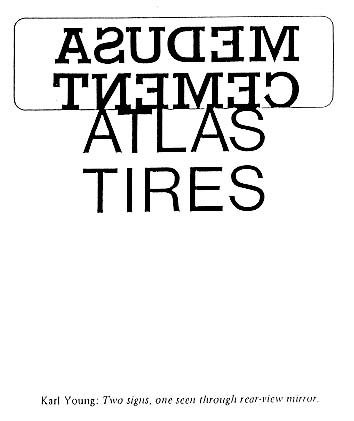
_________________________________________________________
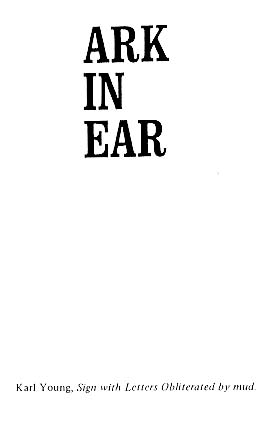
I can't pin it down, but there's something awfully funny about the
sudden intrusion of figures from Graeco-Roman mythology as
formidable as Medusa and Atlas into the everyday of tires and
cement, fore and aft. Since both Medusa and Atlas were turned to
stone by Perseus, they evoke a touch of pathos, too, and a sense of
the final large silences we are all traveling between. More
untaintedly positive is the idea of an ark (as a chest of sacred
texts) in one's ear that centers Young's other poem. When I
described this poem in a letter to poet Dave Chirot, he was
immediately reminded, he said, of a torn scrap of paper on which
the phrase, "Mother Earth," had been reduced to, "other Ear."
A somewhat gnostic example of a minimalistic visual poem is the
one below by John Martone that makes use, like curry's, of a
fingerprint. I haven't fully figured it out, but the fingerprint
reminds me of meteorological maps, and "sea" and "breath" make
me think of the sea as the ultimate (and stormily de-stabilizing!)
source of life.
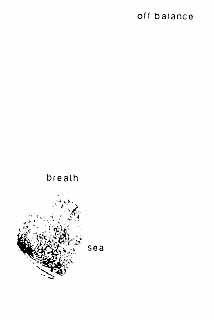
The Englishman, Ian Hamilton Finlay, is one of several visual
poets who has taken the form into color, minimalistically, most
notably in a piece called "King" in which the words, "KING,"
"ohne/titel," "sans/ title" and "without/ a head" are printed in
white down a scarlet page--to rivetingly macabre effect.
Another Britisher, Betty Radin, is among those (including Finlay)
who have made visual poetry three-dimensional--as in her 1972
poem, "Narcissus" (below), a bitter/comic study of the
submergence, or outright drowning, in self-love of a narcissistic
personality's potential for "us-ness" (See Kempton); or is it a
contrast of glamorous but superficial self-involvement to
unglamorous but deeply descending liberation from egocentricity?
Both interpretations, and others, are possible--as is the case in
most of the best poems.
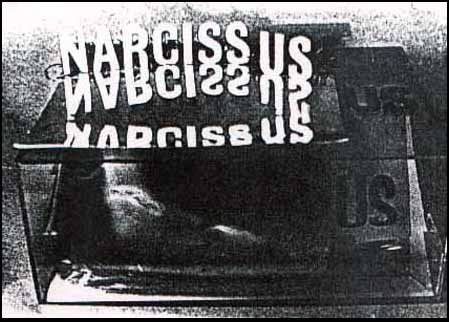
Needless to say, there are other kinds of pluraesthetic minimalist
poetry besides the visual. One is mathematical poetry. Among its
leading practitioners is LeRoy Gorman, whose works in the form
include one called "the birth of tragedy":

Or: tragedy equals a blur of exclamations and questions
multiplying against each other.
Another of Gorman's mathematical minimalistic poems is called
"the day":
un + s = up;
up - s = un.
This seems an apparently minor joke, but I love the thought of
night as an "un," and the beauty of the combination the sun, the
world's centralmost concrete, makes in Gorman's first equation
with the fundamental abstraction, "up." Then, since (according to
Gorman) "un" plus s equals p, "up" minus s must equal "un," as
he has it in his second equation. Straight elementary algebra--but
also something magical if, in it, one can feel the sun
slipping out of the day like a mathematical quantity being
subtracted from a larger mathematical quantity, and turning the
day with an abstract grace beyond clumsy actual astronomical
processes into something that is pure night, and greater.
Another mathematical poem that operates a good deal like
Gorman's is my own "Mathmaku #2":
-
March =
(meadows.)(:/.),
slowly
Here I'm trying to suggest that the effect of winter on the natural
world, as represented by meadows, is similar to the effect of a
period on a sentence: it stops it. Hence, if "March"
multiplies the quantity, "meadows." by the fraction, ":/." as
shown, the result will be "meadows:"--or meadows that are no
longer stopped but in a state of readiness for something to follow.
I'm merely picturing the change of winter to spring, but
suggesting that it has the inevitability and cleanness of
mathematics (in slow motion).
A third variety of pluraesthetic poetry that lends itself to
minimalism is sound poetry, or poetry that makes significantly
more expressive use of sound than conventional poetry, despite
the latter's great dependence on such sound effects as rhythm and
rhyme. It was John M. Bennett who introduced me to this form of
poetry with a text made up of nothing but the phrases, "the shirt,"
and "the sheet," repeated over and over--and over and over and
over and over. Monotonous? Well, as orally presented by
Bennett, it did seem that at first to me. A shirt? Okay. A sheet?
Okay, what else? A shirt? A sheet? Bennett seemed to promise a
poem, and begin a scene, then renege on his promise.
After some initial irritation, I began to like "The Shirt, the Sheet,"
however, for it soon became evident that Bennett was using the
sh**t-form of his two main words primarily as a kind of
wind-instrument to do interesting things to vowels with. And so his
chant blurred down to timbres, temperatures, sizes, colors--at one
point doing nothing but hiss. His sh**t-form had become a
conduit--a chute, if you will--into the elemental myriad-shaped
animality that lurks beneath all language (and which is a cardinal
destination of Bennett's poetry as a whole).
Then Bennett's words began gradually, hypnotically, to reassert
themselves as words--but now wobbling out of themselves into
other words: "dessert, deceit," for instance, and "berserk." Bennett
was repeating his original text into seldom attended extra
resonances. Of course, such a swirl of semi-arbitrary associations
aren't enough to hold one for long. But more was there for me.
The shirt and the sheet started feeling like antitheses--natural
symbols, at length, of . . . Life and Death.
More exactly, I associated the shirt with waking activities,
activities one gets dressed for: work, principally; the sheet, of
course, represented sleep, both the ordinary kind, and the kind
that winding sheets are part of. (Note well, incidentally, the
similarity of the way the words for work and sleep sound to
"shirt" and "sheet.") So: Bennett was using his four words to
portray, in black and white, wail and song, semantics and
growling, the whole great round of work, sleep, work, sleep that
our existence is. How could a poem do more?
Later I happened on a minimalist sound poem by Robert Lax
(with an appreciation by Mary Ellen Solt which is responsible for
nearly all the ideas about the poem that follow). Lax's poem
works in a different way from Bennett's--and on paper! It consists
of four different words only: "the," "stone," "sea" and "water."
These he has arranged in four vertical columns, each composed of
seven stanzas of two one-syllable lines each. The poem begins
with four appearances of "the/ stone"; then "the/ sea" appears
three times. The second column duplicates the first, but each of
the last two columns consists of:
-
wa-
ter
wa-
ter
stone
stone
wa-
ter
stone
The repetitions most obviously
reduce a shorescape to the final essences of stone and sea--not
only by simply focusing entirely on those two things but also by
dulling the text down to something barely heard, barely attended
to as communication (whether heard as speech or heard from a
page)--so that the words for stone and sea are no more than a
breeze when compared with the substance of what they name.
That in each of the first two columns the stone is named in two
couplets, and the sea in a single triplet ever so slightly accentuates
the quicker pace of the latter (as does the easier pronounceation of
"sea.") I said that each line in the poem consisted of one syllable,
but in the second pair of columns, three lines are blank. They still
consist of one syllable as far as I'm concerned, but that syllable is
unpronounced (and counts as a pause). Either viewed or spoken,
then, "stone" is in effect given a period; as a result, its weight
increases substantially, particularly after the construction
preceding it of water's unponderous image. That "stone," unlike
"water," lacks an unaccented second syllable contributes to the
effect, too.
The first two columns help set up this contrast of lithe, mobile
water and stolid, enduring stone by their iambic repetition.
Indeed, one can almost literally feel the water suddenly spill out
of "the sea" when, as "WAter," it is first chanted "downward,"
STRONG BEAT/weak beat, after so many "upward" weak
beat/STRONG BEATS. And note, too, the way the poem shifts
semantically (and rhythmically) from the sea and the stone to
what is in those things: water and . . . stone, thus releasing the
idea of two extremely different kinds of contained fluids.
Appropriately, the poem ends with "stone"--nature's ultimate
earthly matter. And it is with only one appearance of "stone" that
it ends--whereas all the other words or phrases in the poem had
been immediately repeated (except, just once before, the word,
"stone," itself). Thus, with just the right amount of foreshadowing,
the last "stone" occurs with a terrific jolt of finality, of everything's
having truly come to a halt. And so we grow aware beyond mere
first-hand experience of the weight of stone, and the litheness of
water, and of the eternal jar of the sea against the land. In such a
manner does Lax consciously pattern of his sounds to build
expectations he can then defeat to expressive advantage in an
entirely musical way.
For my last piece of evidence for the high value of minimalistic
poetry, I am going to turn to my all-time favorite minimalist
poem, which is probably my all-time favorite poem of any kind,
as well, Aram Saroyan's:
lighght
This is quite a famous, or notorious, poem. Every few years
somebody comes out in print against it. A few years ago, for
instance, the nationally syndicated columnist, William Rusher, was
bemused that the government once (in the seventies) gave an
award to so poor a work of art. I, on the other hand, can still
scarcely believe that the government once gave an award to so
wonderful an artwork. Most people tend to echo Rusher's
view of it, even when they encounter it properly, at the
center of an otherwise blank page--to emphasize its deserving a
full page's worth of attention (as an expression of light, and
only light). Merely glancing at it, they judge its key
element, the extra "gh," a petty eccentricity designed to shock, or a
hoax calculated to win the esteem that obscurity-for-obscurity's-sake
too often receives from academics. They are seriously
wrong: the extra "gh" is neither trivial nor obscure. By putting it
into his word, Saroyan brings us face-to-face with the ineffability
of light, a mysterious substance whose components are somehow
there but absent, as "ghgh" is there (and delicately shimmering)
but unpronounced in the word, "lighght." And he leaves us with
intimations of his single syllable of light's expanding, silently and
weightlessly, "gh" by "gh," into . . . Final Illumination.
Copyright © 1997 by Bob Grumman
Return to
Light and Dust Poets.
Light and Dust Mobile Anthology of Poetry.
�������������










